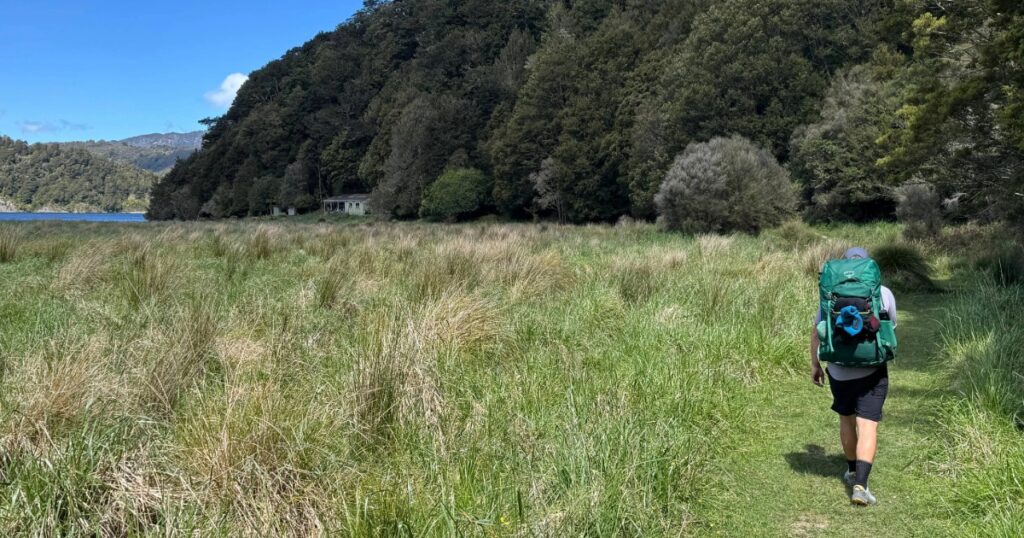New Zealand has 11 Great Walks, which each take anywhere between 2 and 5 nights to complete. Lake Waikaremoana, on the North Island, is one of the most unique. I just got back from the 4-day hike with friends and had an amazing time. I was like, 99% prepared, but there were a few things I wish I’d known before we went. Here’s everything you need to know to prepare for your stay at the Lake Waikaremoana huts!
This post may contain affiliate links. Bookings or purchases through these links generate a small commission for me at no extra cost to you. Thanks for your support!
The Lake Waikaremoana track
You can do the Lake Waikaremoana track in either direction, but I love a hike that starts out difficult and gets progressively easier. So I really recommend tackling Lake Waikaremoana in the clockwise direction, starting in Onepoto. (This is what I did.)

I know this map is a bit hard to see, especially if you’re on your phone. But basically: If you start in Onepoto you’ll gain 500 metres of elevation over 9 kilometres before you reach Panekire Hut. From there, it’s pretty much downhill for 8 kilometres until you reach Waiopaoa Hut. And then “flat” for the remaining 32 kilometres of the track. Undulating terrain, of course, but no major slogs uphill or cruel switchbacks.
There’s more info on the track here.
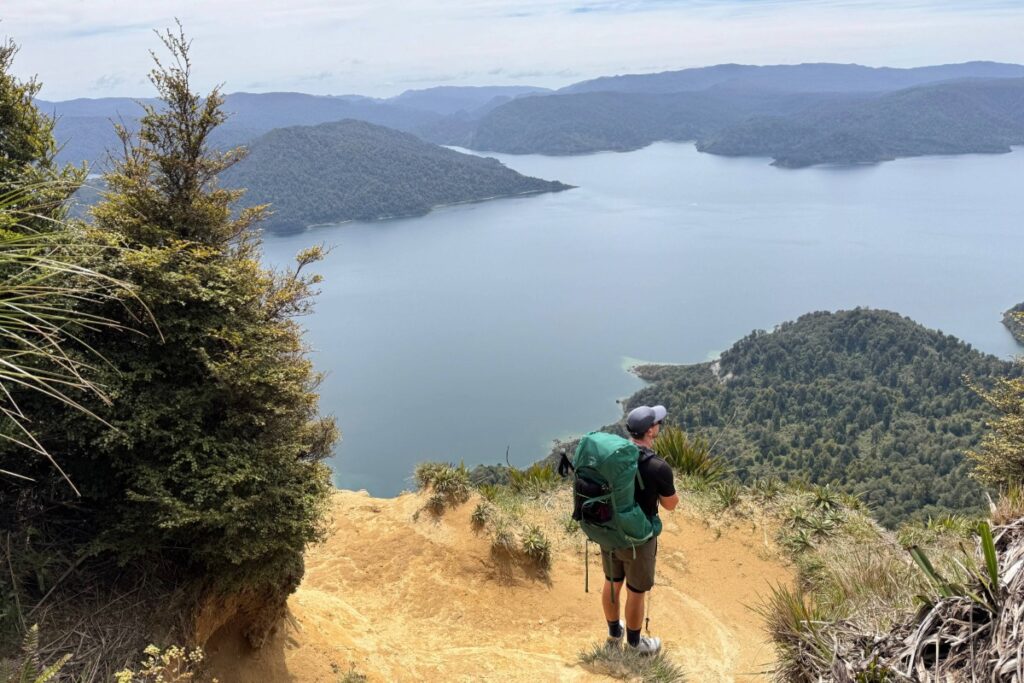
On the way up to Panekire Hut
All about the Lake Waikaremoana huts
The huts along the Lake Waikaremoana route are comfortable. But not quite as flash as the ones on the Milford Track or Kepler.
It’s important that you bring everything you need, as they’re not very well-equipped and you might find yourself in the lurch if you forget something!
We met two guys who didn’t bring a gas cooker, so they had to ask some kind strangers (us) to borrow cooking equipment at every hut. Me? I assumed the huts would provide toilet paper — they do not. Fortunately, my friends were more prepared and able to share.
What the huts DO have
- Shared bunk rooms with mattresses
- Shared kitchen area with sinks
- Dining tables
- Dish towels and soap
- Potable water (mostly)
- Long drop toilets (outside)
- Fireplace and clothes rack
What the huts DO NOT have
- No bedding
- No cooking equipment (no stoves, lighters, pots, pans, cutlery)
- No hand soap
- No showers
- No garbage bins
- No toilet paper
- No cell service (except Panekire Hut)
- No electricity
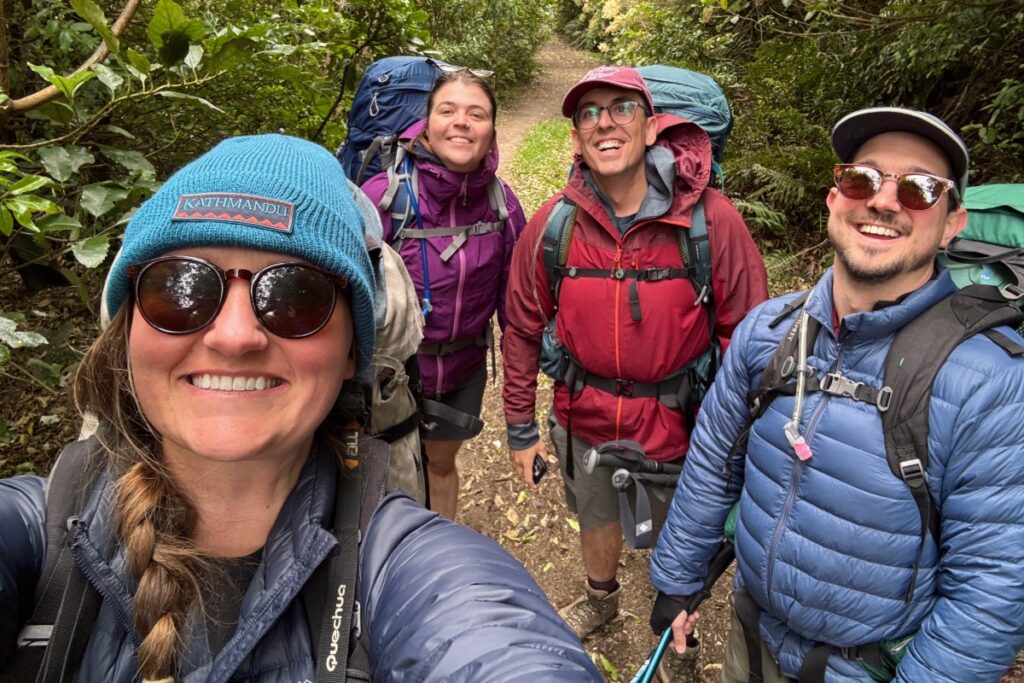
The better-prepared friends
What you need to pack for the Lake Waikaremoana Huts
To make sure you’re super clear on what you’ll need for a comfortable hut experience, here’s a little checklist.
- A sleeping bag
- Slip on shoes for around the hut
- A gas cooker and gas cannisters
- A lighter and/or matches
- Pots, plates, cups, and cutlery
- Hand soap and/or hand sanitizer
- A dish towel (for drying — the ones provided get wet as they’re shared)
- Tupperware container to pack out garbage
- Extra Ziplock bags
- Toilet paper
- Emergency medical kit
- External phone battery
- Water filter or sterilization tabs
- Head lamp
- Tea candles or long wax candles for table light
- A card game and/or book for downtime
- A swimsuit if you want to swim in the lake or at the waterfall
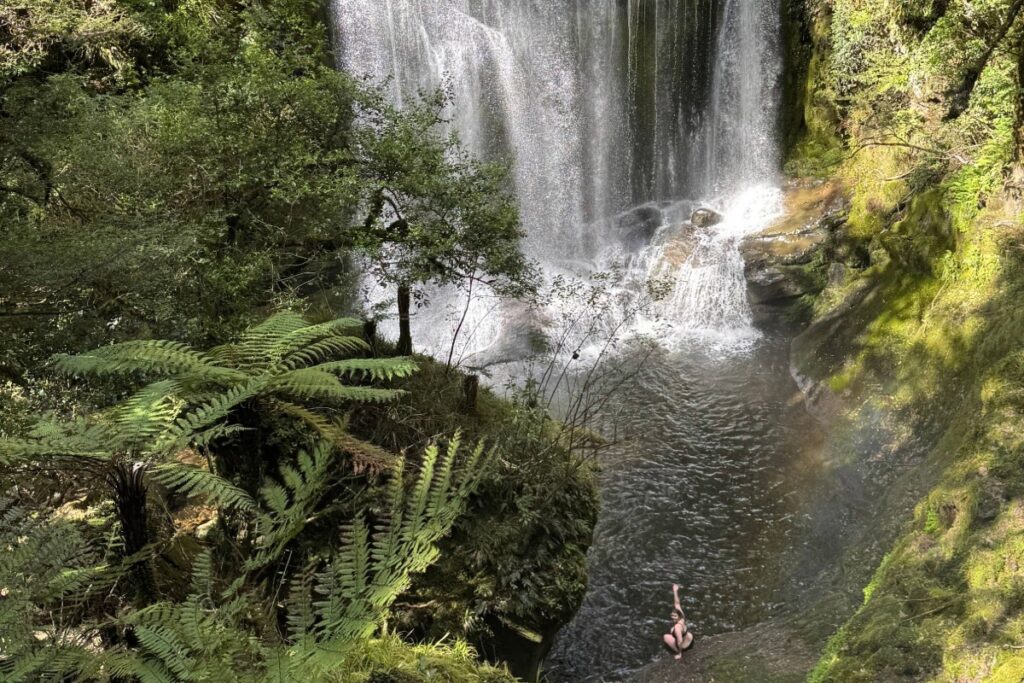
Swimming at Korokoro Falls
The 3 Lake Waikaremoana Huts I stayed at
There are several huts to choose from along the trail and they are not all created equal. My friends and I did the hike in 3 nights/4 days. But it’s possible to do it in 2 nights if you’re quick or extend it to 4 nights if you want to go at a more relaxed pace. However, I think what we did is the most common way people do the route.
Panekire Hut
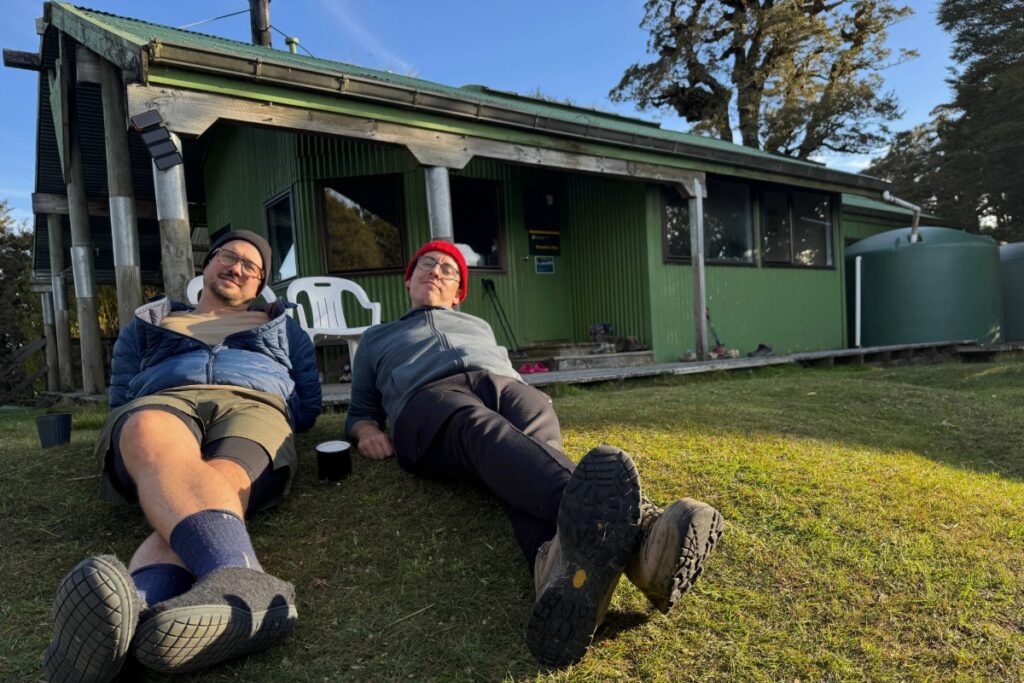
Boys outside Panekire Hut
There’s a stunning view from this hut, looking out over the lake where you can appreciate just how high you’ve hiked. The kitchen is pretty spacious and the hut warden kept the fire going so it was nice and cozy even in October. I had one bar of cell service up here, so if you’re really jonesin’ to post a picture from the trail (like meee) this is your one and only chance.
Attached to the kitchen, there are 40 bunks split across two rooms. The sleeping situation was fine for us because we arrived early enough to snag a bottom bunk. But the people who got there late? They had to climb all the way up to the third story bunk. I believe this should be illegal.
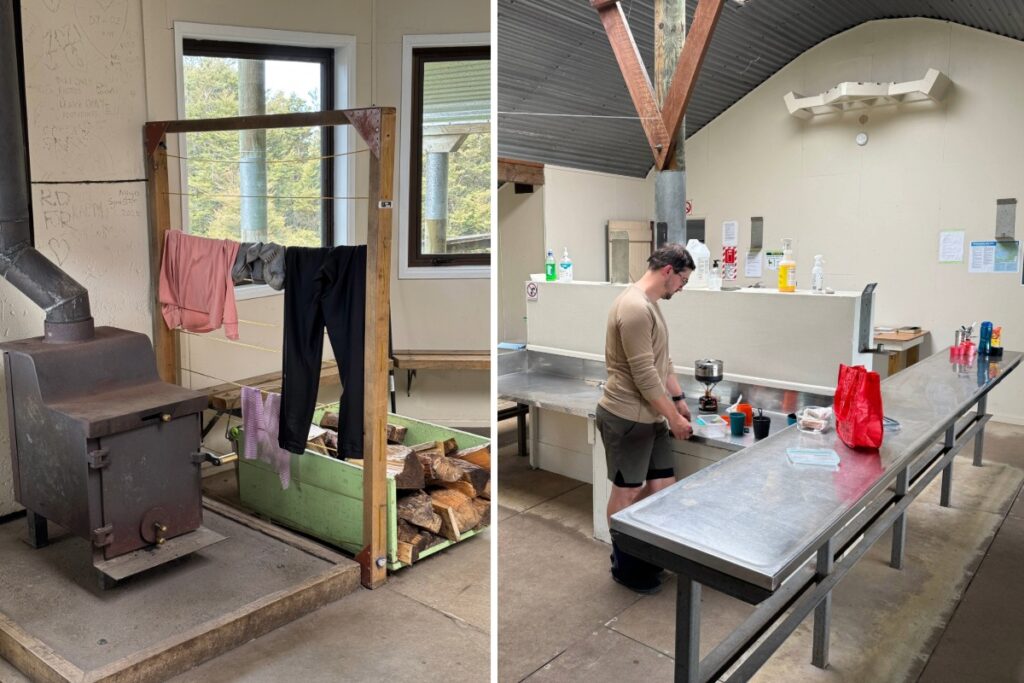
Inside Panekire Hut
A few steps from the main hut are the two long drop toilets. Two toilets for 40 people is also pretty wild in my opinion, but as far as long drops go, they were fine. Well-kept without too many bugs inside. This is why you’ll definitely want a head lamp — in case of any middle of the night bathroom visits.
The signs tell you not to drink water from the tap. But the hut warden drinks it, we drank it, and we were fine. That said, a water filter will give you some peace of mind.
Our hut warden was the best. The talk (something they do every night to say hello and give everyone a safety briefing) involved a welcome ceremony unlike anything we’ve experienced at a hut on ant Great Walk tracks. He did it all in Te Reo and then gave us a brief translation. He also sang a song written by one of his ancestors, and then opened the floor to everyone to introduce themselves. He was also very keen on getting us to sing, so if you’re brave enough, prepare a little song before you go!
Waiopaoa Hut
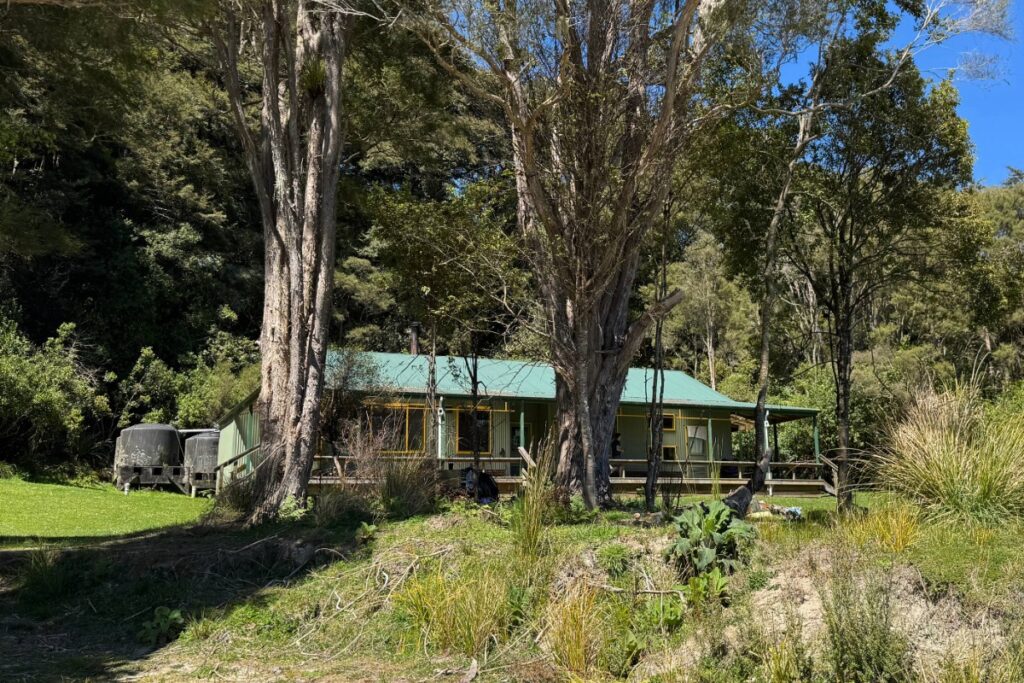
This lakeside hut was my favourite. It had the most comfortable bunk set up with just two tiers. And a little ledge at the boot of the bed for your stuff. The kitchen was still spacious and there was even hand soap provided — a luxury! This one also had two long drop toilets just a short walk away from the kitchen/sleeping building.
Waiopaoa Hut doubles as a campground, so there were 30 bunks and 18 campers when we were there, all sharing the kitchen and toilets. That was the only downside for me. But all in all this was definitely my favourite hut. It’s right on the lake and has a little beach so you can even go for a swim if you don’t mind the cold. However, there are sand flies! So make sure you bring some Goodbye Sand Fly — it really works.
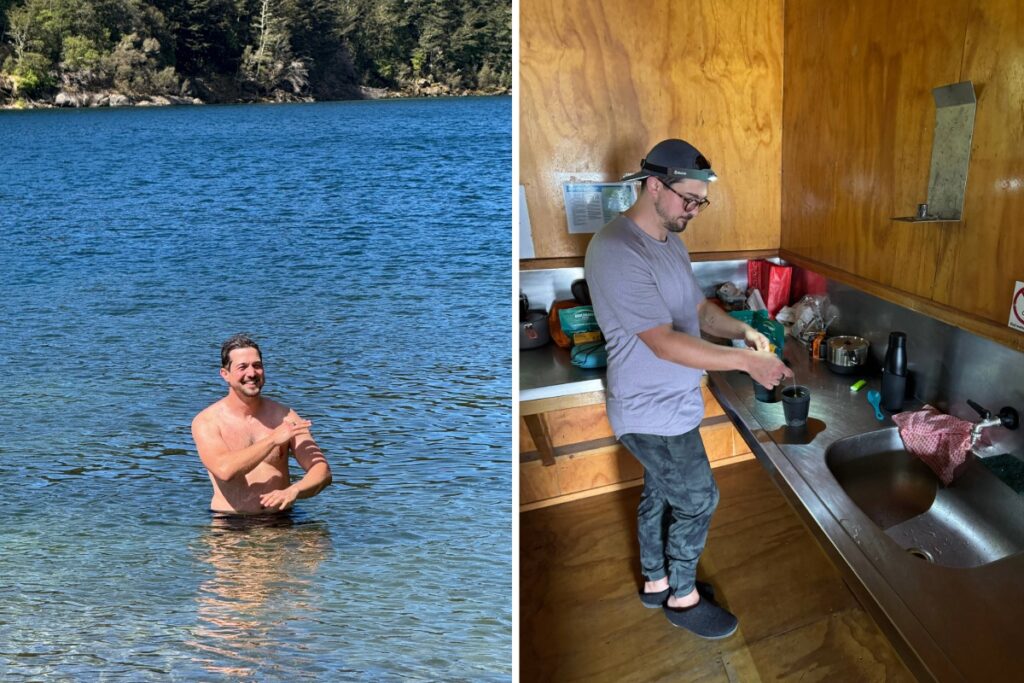
Swimming and cooking at Waiopaoa Hut
Here, we had another amazing hut warden. She shared a story about Maui and sang a song in Te Reo during her hut talk. And afterwards, she was happy to chat about her community and the new partnership between the local Tuhoē people and DOC.
She also told us the hut wardens are able to help you with your itinerary and can contact the water taxi or adjust your hut bookings (if there’s availability). We never needed that, but it’s super helpful to know if, for example, you decide you want to change your water taxi pick up time when you’re already on the trail!
Marauiti Hut
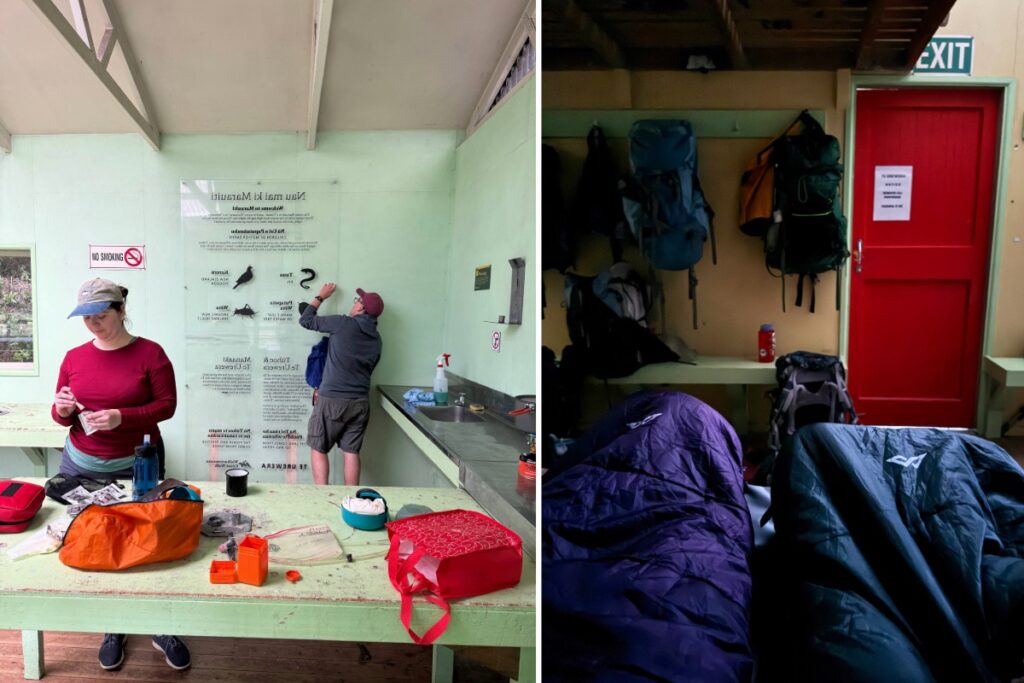
Marauiti Hut kitchen and bunk room
This one is more like a backcountry hut. No bells and whistles, no hut warden, just some shelter and a space to cook. It sounds like the water is usually safe to drink, but there were big bold, underlined signs when we went, warning us against it. They suggested we drink from the lake instead and boil everything.
Fortunately, we had a LARQ bottle to sterilize the water so we didn’t have to boil every pot and let it cool down before pouring it into our backpack bladders for the next day. Long story short: This is why it can’t hurt to bring some type of water filter/sterilization system.
While this hut was fine, I strongly recommend you keep on trekkin’ over to Waiharuru Hut for a more comfortable experience.
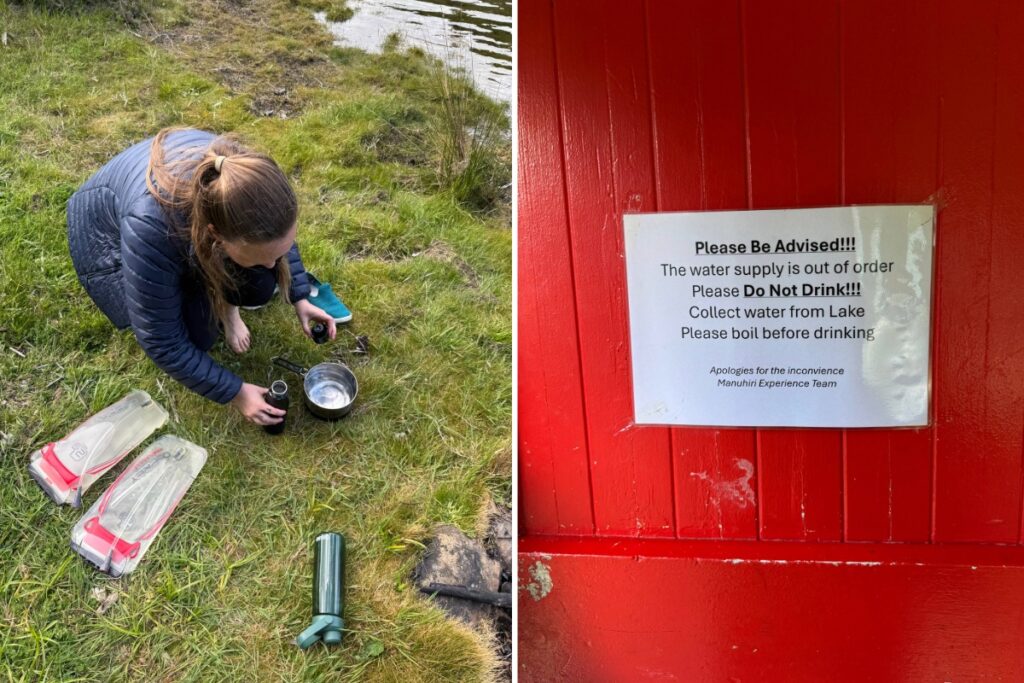
Using the LARQ for clean drinking water
Marauiti Hut was on the smaller side, with about 26 bunks and like, 2.5 levels of bunks. So just 2 with an extra little loft-y area for about 4 bunks.
It had 2 long drop toilets that were the worst ones I encountered on the trip. The inside cooking area was basic but it had a nice little sign with information about the area and some local wildlife… which was flipped the wrong way around per the photo above. Don’t worry, we fixed it.
Other huts and campsites along the Lake Waikaremoana track
There are two alternative huts you can book on the route:
- Waiharuru Hut: If you think you have it in you to press on from Waiopaoa Hut to pass Marauiti, do that. Marauiti was grim, and Waiharuru is new and spacious and beautiful. It also gets you closer to the finish line so you have an easier last day to the water taxi.
- Whanganui Hut: You don’t really ever need to stay here. It’s close to the end of the trail (or beginning, if you go the other direction) so I don’t see a reason to book this hut.
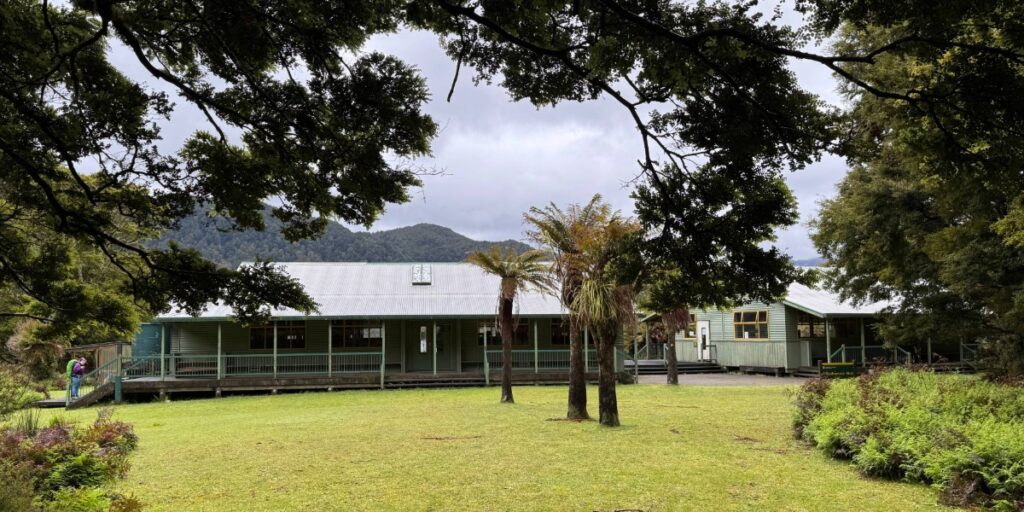
The new Waiharuru Hut
If you like things a bit more rustic and don’t mind carrying a tent, you can also camp rather than sleep in the huts around Lake Waikaremoana. You can even book a mix of both so it’s two nights camping, one night hut, or whatever. I don’t have much to say about the campsites because I only stayed in the huts. But we saw some people with pretty nice lakeside set ups!
- Waiopaoa Campsite
- Korokoro Campsite
- Marauiti Campsite
- Waiharuru Campsite
- Tapuaenui Campsite

Korokoro Falls, Day 3 of the Lake Waikaremoana Track
Lake Waikaremoana Holiday Park
If you stay at the Lake Waikaremoana Holiday Park the night before/after your hike, you’ll be relieved to know it’s a bit more well-equipped than the huts. That said, it’s still pretty rural and more rustic than a Top 10 Holiday Park.
The cabins are small and basic and you still need your own sleeping bag, but they provide you with a pillow. There’s a fridge and microwave in the room with a few plugs so you can charge everything up before the hike. Then there’s also a fully-equipped communal kitchen with stoves, ovens, a kettle, garbage bins, etc. You can even do laundry!
There’s no cell reception at the Lake Waikaremoana Holiday Park, but you can walk or drive over to the visitor centre for free wifi between 8am and 5pm. The visitor center is beautiful, worth a visit just to see the “living building.” And they have a coffee machine that’s nicer than the instant stuff at the small campground shop.
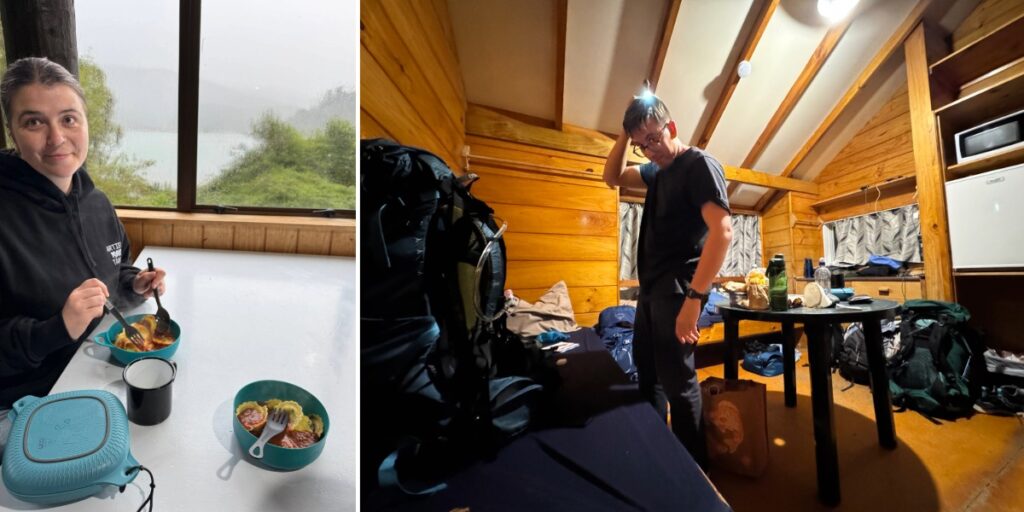
Other tips to prepare for the Lake Waikaremoana Great Walk
Here are some miscellaneous tips I have for making the most of your epic Lake Waikaremoana hike.
- Book the water taxi, but don’t panic. Everyone I spoke to had a similar experience to ours, where we tried to book the water taxi months in advance and only heard back like a week before the hike. I promise you it will all be ok, and you won’t be stranded. If you never hear back, the team at the visitor centre or the hut wardens can help you out.
- Leave snacks in the car. You will be so thankful to have a little treat once you get off the trail — especially if it’s raining. There’s absolutely nothing nearby. Choose something other than scroggin or the other trail snacks you’ll be sick of.
- Get to the huts early for ideal bunk selection. Some of the huts have a diabolical 3-story bunk situation. I can’t imagine anything worse than sleeping up there after a long day of hiking.
- Pack a swimsuit (if you don’t mind cold water). Some of the huts are lakeside and you can swim at Korokoro Falls.
- Do a little research on Ngāi Tuhoē. It will help you better understand and appreciate the unique and complicated partnership between the local community and the Department of Conservation (DOC) in managing this trail. Most Great Walks are DOC-only.
- If you’re coming from Auckland, stay in Rotorua after the hike. Hit those hot pools or mud baths and relax your aching muscles! You’ll be thankful you chose to break up the long drive.

